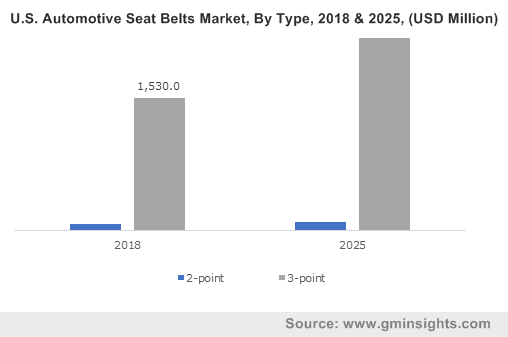How will automotive seat belt market trends be impacted by ongoing road safety initiatives and digital transformation of the automotive industry?
Publisher : Fractovia | Published Date : May 2019Request Sample
Increasing road safety awareness and ongoing initiatives to lessen the severity of road crash injuries have been equipping automotive seat belt market players with continuous development opportunities. The momentum gained by several safety projects worldwide would undeniably propagate the importance of automotive seatbelts and consequences of ignoring them, highly boosting their usage over the forthcoming years. Seatbelts, especially when paired with airbags, have changed automobile safety dynamics to such a fundamental level that today it is difficult to even imagine a vehicle without these protective features.
U.S. Automotive Seat Belts Market, By Type, 2018 & 2025, (USD Million)

Reportedly, seatbelts are able to reduce front-seat passenger fatalities be approximately 45% while also reducing the risk of severe injury by nearly 50%, which is exactly why they come as standard in automobiles today. Supported by the ongoing digital transformation of the automobile industry, auto makers have been making significant inroads in further enhancing the capabilities of their seatbelts to promote higher safety, bringing remarkable growth to the automotive seat belt market in recent years.
Impact of ongoing road safety initiatives on the global automotive seat belt market
The Need: The safety benefits of seatbelts have been proven many a times throughout the history of automobiles. Yet, even after studies show that one’s chances of surviving a severe road crash are doubled when seatbelts are used, a sizable chunk of vehicle operators chose to not use them. These conditions, consequently, have given rise to several road safety initiatives across the world that aim to bring more seatbelt awareness to passengers.
The Numbers: In fact, according to Volvo, the company that invented the three-point automotive seat belt which is the most widely used seatbelt design in the world, more than 7,000 lives across the European Union alone can be saved on an annual basis if the vehicle passengers choose to use their seatbelts.
The numbers get significantly bigger moving east towards low-middle income countries, where the reasons why seatbelts are not worn give all the more importance to the road safety awareness initiatives. For instance, a survey conducted by Maruti Suzuki in India found that approximately 27% of the individuals surveyed claimed they do not use seatbelts as it impacts their image negatively, while 25% claimed that the belts wrinkle their clothes.
The Projections: Several social campaigns are being conducted to eliminate the aforementioned notions and highlight the importance of seatbelts. These campaigns are increasingly finding success in their endeavors in recent years, thus steadily increasing the scope of the automotive seat belt market and subsequently opening up the industry to future advancements and growth. The key factor promising tremendous remunerations for the automotive seat belt market is the expansive manufacturing of automobiles globally.
Impact of ongoing advancements in automotive technologies on the automotive seat belt industry
The Demand: According to the World Economic Forum, technological advancements such as the internet, smartphones, cellular and wireless communication have brought an unwavering supply of conveniences to day-to-day lives, with consumers expecting those conveniences from their vehicles as well.
The Possibilities: The onset of the industry’s digital transformation has opened up new growth opportunities for the automotive seat belt industry, wherein features such as seatbelt reminders, intelligent seatbelts, intelligent ignition systems are being integrated by automakers to enhance their vehicles’ safety quotient. With customers increasingly giving more importance to safety, these improvements are slated to ensure an increase in sales for automakers who facilitate these features, which would be driving the incorporation of new automotive seatbelts in popular vehicles.
The MVP: One of the biggest advancements in the field of seatbelts and airbags is notably when Daimler invented the beltbag – a combination of seatbelt and airbag. The invention was made possible by the technological advancements that ware made in crash sensors. Apparently, the crash sensors in Daimler’s cars were capable of gauging the severity of the crash, which allowed a gas generator to rapidly inflate the seatbelt, thus reducing injuries to ribcages when the car got into a serious crash.
Fueled by the notable road safety campaigns, advancements in seatbelt technology and consistent automobile production, the automotive seat belt industry is projected to record momentous expansion in the coming years. According to trusted estimates, global automotive seat belt market size is slated to exceed the $10 billion renumeration mark by 2025.